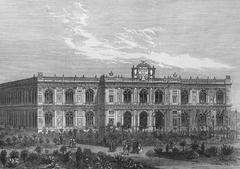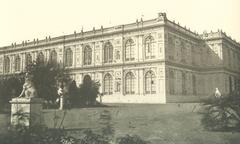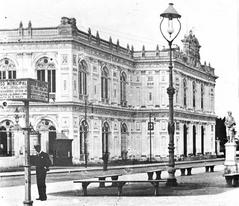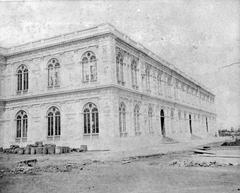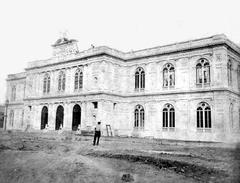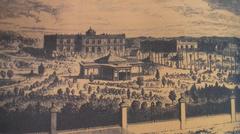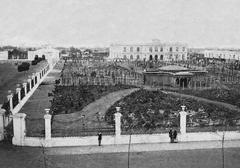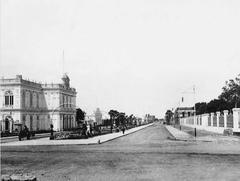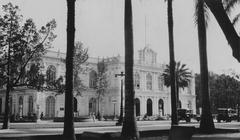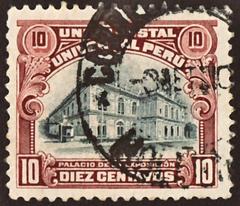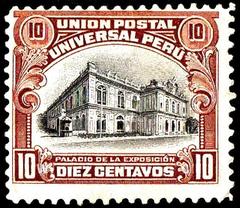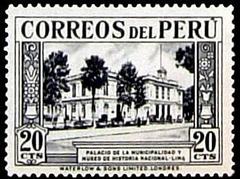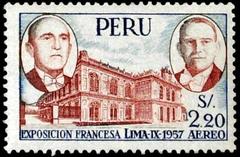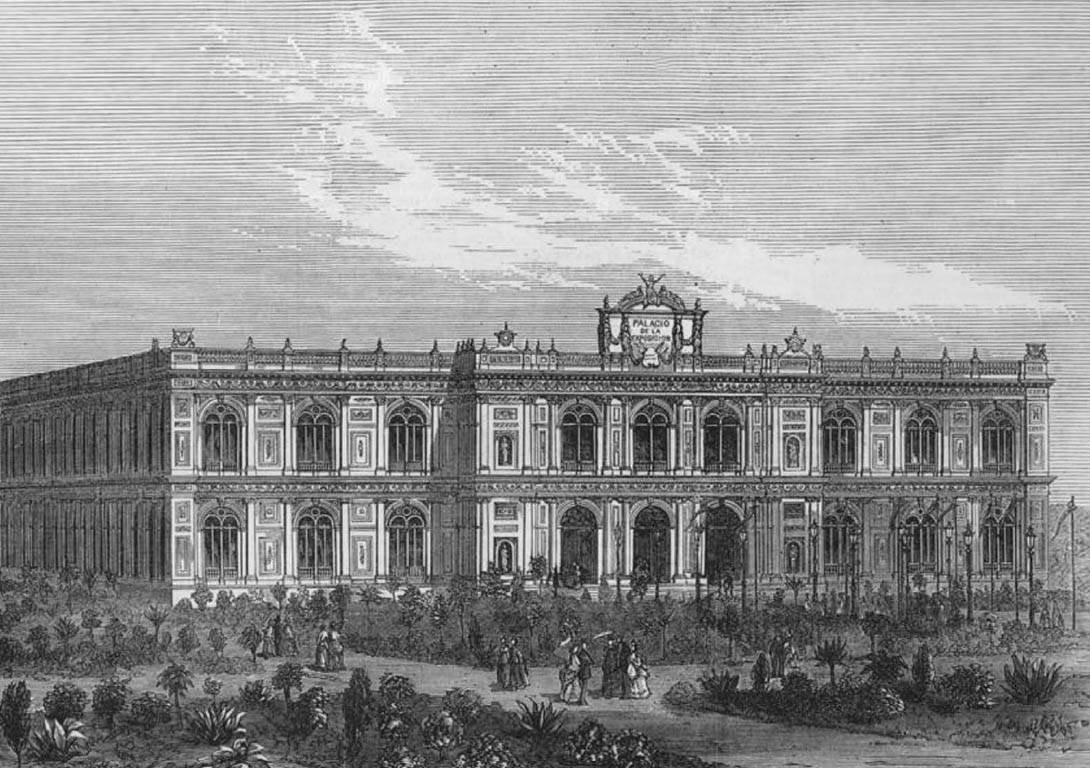
Palacio de la Exposición, Lima: Comprehensive Visitor Guide
Date: 14/06/2025
Introduction
The Palacio de la Exposición, located in Lima, Peru, is a masterpiece of 19th-century architecture that stands as a testament to the nation’s drive for progress and cultural expression. Originally built to host Peru’s First National Exposition in 1872, this landmark now houses the renowned Museo de Arte de Lima (MALI), offering visitors a unique blend of historical grandeur and vibrant contemporary culture. This guide details the palace’s historical context, architectural significance, visiting hours, ticketing, accessibility, nearby attractions, and essential travel tips—making it your go-to resource for planning an enriching visit. Whether you are a history enthusiast, art lover, or curious traveler, the Palacio de la Exposición is an essential stop on your exploration of Lima’s cultural heritage (Urbipedia, Medium).
Historical Background and Cultural Significance
Origins and Construction
The inspiration for the Palacio de la Exposición came in 1869 under President José Balta, who envisioned a monumental venue to celebrate Peru’s achievements. Italian architect Antonio Leonardi was commissioned to design the palace, merging European Neoclassical, Baroque, and Neo-Renaissance influences with local building traditions. The construction, completed in 1872, marked a major milestone in Lima’s urban development and established the palace as a symbol of national progress (Academia.edu).
Architectural Innovation
Pioneering for its time, the palace utilized imported iron columns from France—an engineering feat in 19th-century South America. The structure’s façade, adorned with grand arches and ornate cornices, was influenced by the palaces of Venice and Versailles. Leonardi’s design also integrated local construction methods, including quincha for the upper floors, ensuring both resilience and elegance (ArchDaily, Urbipedia).
Cultural Role over Time
Since its inauguration, the palace has been central to Lima’s civic and cultural life. It hosted major exhibitions, scientific demonstrations, and public events. During the War of the Pacific, the building was repurposed as a hospital and administrative center, suffering damage and the loss of original features, such as marble lions and ornate ironwork. Restoration efforts in the 20th century, including a major campaign in 1956, revitalized the palace for its new role as the home of MALI (Wikipedia, MALI).
Architectural Features
- Neorenaissance and Baroque Façade: The palace’s exterior showcases symmetrical arches, decorative pilasters, and Renaissance motifs, evoking European palatial architecture (Urbipedia).
- Structural Ironwork: Large cast-iron columns, imported from France, support expansive galleries and allow for modular exhibition spaces (ArchDaily).
- Interior Layout: Spacious halls, wide staircases, and abundant natural light create an environment suitable for large exhibitions and public gatherings.
- Integration with Park: The palace is the centerpiece of the Parque de la Exposición, surrounded by formal gardens, fountains, and pavilions in diverse architectural styles (Parque de la Reserva).
Transformation into a Cultural Hub
Museo de Arte de Lima (MALI)
Since 1957, the Palacio de la Exposición has been home to the Museo de Arte de Lima. MALI hosts over 19,000 works, spanning pre-Columbian, colonial, republican, and contemporary art. The museum is a dynamic venue for exhibitions, educational programs, and community events, reinforcing the palace’s role as a living cultural institution (MALI, Museu.ms).
Educational and Social Outreach
MALI provides workshops, guided tours, lectures, and cultural fairs. Its specialized library and archive support art research, while public programming fosters creative engagement for all ages (Museu.ms).
Visiting Information
Location and Getting There
- Address: Paseo Colón 125, Parque de la Exposición, Lima 15046, Peru (MALI official site)
- Transport: Easily accessible by taxi, bus (e.g., Corredor Azul), and metro (Estación Central). Underground parking is available for a fee (MALI visitor info).
Opening Hours
- Tuesday – Sunday: 10:00 a.m. – 6:00 p.m. (Saturdays until 5:00 p.m.)
- Closed: Mondays and certain holidays (MALI official site)
Tickets
- General Admission: S/ 15.00 (approx. $4 USD)
- Discounts: S/ 7.50 for accredited teachers; reduced rates for students and seniors with ID
- Free Entry: Thursdays until March 13, 2025; special events like “Noche MALI” offer evening access at a discounted rate (MALI ticketing)
- Purchase: At the ticket office or online via Joinnus. Tickets are non-refundable and non-exchangeable.
Accessibility and Facilities
- Wheelchair Access: Ramps, elevators, and accessible restrooms throughout the museum (Portal Breña).
- Cloakroom & Shop: Secure storage for bags; museum shop offers books and crafts.
- Café: On-site café for light meals and refreshments.
- Wi-Fi: Free in public areas.
Photography
- Personal Use: Permitted without flash. Selfie sticks and tripods are not allowed.
- Professional Use: Requires advance permission (MALI photography policy).
Guided Tours
- Available in Spanish and English; advance reservation recommended (MALI guided tours).
Collection Highlights
- Permanent Collection: Over 12,000 pieces from pre-Columbian ceramics and textiles to modern installations (WhichMuseum).
- Temporary Exhibits: Regularly rotated, featuring Peruvian and international artists (MALI exhibitions).
- Special Events: Includes film screenings, artist talks, and fairs like Feria del Patio MALI (MALI blog).
Nearby Attractions
- Parque de la Exposición: Landscaped gardens, fountains, and architectural pavilions (El Comercio).
- Teatro La Cabaña and Anfiteatro Nicomedes Santa Cruz: Host cultural and musical events.
- Plaza San Martín and Lima’s Historic Center: Within walking distance, ideal for a day of cultural exploration.
Visitor Tips
- Best Time to Visit: Mornings and weekdays for fewer crowds; free admission days can be busy.
- Duration: Allow 2–3 hours for the museum and park.
- Language: Most signage is in Spanish; English tours and materials are available.
- Payment: Cash, credit/debit cards, and Yape accepted for tickets and parking.
- Safety: The area is safe during museum hours, but use standard precautions, especially at night.
Frequently Asked Questions (FAQ)
Q: What are the visiting hours?
A: Tuesday to Sunday, 10:00 a.m. to 6:00 p.m.; closed on Mondays.
Q: Where do I buy tickets?
A: At the museum or online via Joinnus (MALI ticketing).
Q: Is the museum/wheelchair accessible?
A: Yes, with ramps, elevators, and accessible restrooms.
Q: Are guided tours available?
A: Yes, in both English and Spanish with prior reservation.
Q: Can I take photos?
A: Yes, for personal use and without flash.
Preservation and Recognition
The Palacio de la Exposición was declared a National Historic Monument and Cultural Heritage of the Nation in 1973, ensuring its ongoing preservation and highlighting its importance as a symbol of Peruvian identity (MALI). Recent restoration projects have improved accessibility, safety, and enhanced the visitor experience.
Final Recommendations and Call to Action
The Palacio de la Exposición is a cornerstone of Lima’s cultural landscape, offering a journey through Peru’s artistic, architectural, and social evolution. Its accessible location, rich programming, and connection to adjacent landmarks make it an ideal destination for all visitors. For updated visiting hours, ticketing, and events, always check the official Museo de Arte de Lima website or download the Audiala app for real-time guidance, tours, and cultural updates.
Share your experience on social media using #PalacioDeLaExposición and help celebrate Peru’s living heritage!
Reliable Sources and Further Reading
- Palacio de la Exposición en Lima: Visiting Hours, Tickets, and Historical Significance, Academia.edu
- Palacio de la Exposición in Lima: Architectural Marvel and Visitor’s Guide, Urbipedia
- Palacio de la Exposición in Lima: Architectural Marvel and Visitor’s Guide, ArchDaily
- El Palacio de la Exposición, Medium
- Palacio de la Exposición, Wikipedia (English)
- Museo de Arte de Lima, Official Site
- MALI Visitor Information
- Parque de la Exposición, Parque de la Reserva
- Lima Art Museum, WhichMuseum
- MALI on Museu.ms
- El Comercio: Parque de la Exposición
- Portal Breña
